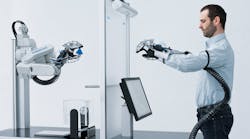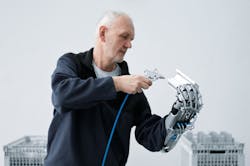Need help opening a stubborn pickle jar? ExoHand may one day assist with everything from mundane tasks to factory floor automation. This uber-sophisticated robotic hand is an exoskeleton that is worn like a glove and used to amplify finger force. Engineers at Festo Corp., Hauppauge, N.Y., share design details behind the ExoHand, which recently debuted at Hannover Fair.
What inspired Festo to develop the ExoHand?
Inspiration came from a desire to realize direct human-machine interaction. The objectives of the ExoHand project are to enhance the strength and endurance of the human hand, to extend the human scope of action, and to help secure an independent lifestyle for people at an advanced age. These medical advantages, along with interest in automation assistance systems, motivated our engineers to collaborate with Tьbingen University Hospital in Germany as part of our Bionic Learning Network.
Tell us about the components that make up the ExoHand.
Eight double-acting pneumatic actuators — Festo's DFK-10 cylinders — are attached to the exoskeleton structure, allowing the wearer to move the fingers of the orthosis with utmost precision. A CoDeSys-compliant controller registers and processes positional and force parameters. It also regulates the pressures in the cylinders with nonlinear control algorithms, to ensure correct finger positions and forces. Linear potentiometers register both finger positions and the force applied by each individual drive unit. The corresponding pressure in the various chambers is regulated by means of piezo proportional valves. Pressure sensors on the valve terminal serve to regulate the pressure and give an indication of the forces exerted by the cylinder.
Is each ExoHand customized to fit a unique human hand?
Yes. The ExoHand is manufactured from polyamide using selective laser sintering (SLS) — an additive manufacturing process that produces the exoskeleton based on a 3D scan of the user's hand.
Where will the ExoHand be used?
Applications include service robotics featuring humanlike hands, a human assistance system (as a force booster for assembly work), remote object manipulation in hazardous environments (ExoHand placed over a silicone hand), and rehabilitation for stroke patients who have lost use of a hand.
For stroke patients, how would rehabilitation work?
The broken signal routing between the patient's brain and hand is artificially connected by using a brain-computer interface. The patient's desire to open or close the hand can be detected by measuring the brain's EEG signals. The ExoHand reacts to these signals by opening or closing the patient's hand. The result is a training effect, which over time helps patients move their hand again without any technical assistance.

